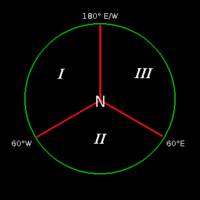World
A world is the name generally given to celestial bodies, such as planets and their moons.
World Types
There are several sets of properties of worlds, that are orthogonal to each other. The main, and most influential property is the solar orbit zone in which the world located. There are five orbit zones:
- Inferno worlds orbit closest to the sun and can be gaseous, seas of lava or barren desert-like plains. Magmex, ioplasma, vulcanite, and phlogiston are found only on these worlds.
- Inner worlds orbit between the inferno and habitable zones. These worlds can support primitive plant and animal life, but they are too warm to support intelligent life. Terrain and resources on inner planets are very similar to terrain and resources on habitable planets. Inner planets are breathable if the atmosphere is standard or tainted with a density between 15%-85%.
- Habitable worlds are always habitable without additional life support, and are the easiest to reach self-sufficiency. Homeworlds are always habitable worlds. A wide range of basic resources are found here as well as plant and animal life. They are comprised of land and seas of water. Each habitable zone is able to produce 1 officer.
- Outer worlds function like inner planets, but they are too cold for intelligent life instead. However chances of ice and lumenite are much higher than for warmer worlds.
- Frigid worlds are icy planets which cannot support life. They can be barren snow plains or may have seas of liquid gases which are highly damaging to unprotected life and equipment. Cryozine, bolite, myrathane and polytaride are found only on these worlds.
For more information, see Orbit Zone.
Celestial Bodies Types
There are also different types of planetary bodies:
- Gas Giants have a massive dense atmosphere and strong gravity, that can heavily damages unprepared spacecraft and complicates colonization. They often have moons and can have large moons.
- Planets have atmospheres and surface liquids (lava, water or supercooled liquid depending on their orbital zone), and are able to support large populations. Planets can have small airless moons.
- Large Moons are basically planets orbiting a gas giant.
- Moons are smaller and have no atmospheres nor surface liquids. They have a higher chance of containing eludium and lumenite, but will be easily overpopulated. They are found orbiting gas giants and planets.
- Ringworlds are rare artificial worlds which surround a star. The worlds are the same as habitable worlds but are contained within a trough facing inwards to the star, a second orbital layer of plating artificially replicates a day and night cycle.
- Asteroid Rings - Many worlds have asteroid rings surrounding them. Various materials, such as ice and stone, can be harvested from these using a prospector bay.
Resource Zones

Planets and ringworld arcs are divided into one or more resource zones, like an orange divided into equal slices. The map on the Locator (F7) window displays longitude lines at the divisions between the resource zones.
Most planetary resources are distributed into resource zones. Resource quality and abundance varies by zone. A resource that is rare in one zone may be plentiful in another zone. Similarly, a resource that is poor in one zone may be superb in another zone.
Atmospheric and hydrographic factors do not vary by zone. The quality and quantity of these commodities is the same across the entire world.
The only visible change from one zone to the next is the appearance of the plant life. Otherwise, you must spot the terrain to watch for a change in resource quality to notice that you are in a different zone.
The zone changes go as following:
- Zone 1: 180°W-60°W
- Zone 2: 60°W-60°E
- Zone 3: 60°E-180°E
Ringworlds however only have 2 resource zones:
- Zone 1: 180°W-0°W
- Zone 2: 0°E-180°E
World Population
Citizens experience dissatisfaction due to population pressure when the resource zone population limit is exceeded. Population of a resource zone is the sum of the population of all cities whose town square resides in the zone, even though portions of cities may overlap multiple resource zones. Citizens become increasingly unhappy the more the population exceeds the limit. Overpopulation affects morale of citizens (-1 for every 5% additional population) and increased risk of disease outbreaks.
The diameter of a world can be found:
- On a city report from a city on the planet
- On a system survey report
- On sensor details
| World Diameter |
Resource Zones |
Resource Zone Population Limit |
|---|---|---|
| 1800 | 1 | 100 |
| 3800 | 1 | 200 |
| 5600 | 3 | 300 |
| 7600 | 3 | 400 |
| 9400 | 3 | 500 |
| 11400 | 3 | 600 |
| 15200 | 3 | 800 |
| 17000 | 3 | 900 |
| 19000 | 3 | 1000 |
| 20800 | 3 | 1100 |
| 22800 | 3 | 1200 |
| Ringworld | 2 | 1000 |
The formula for zone population limit is: PopulationLimit = 100 * FLOOR( PlanetDiameter / 1'800 )
Indigenous People
Worlds have an indigenous population if they have a habitable environment and they orbit in the habitable orbit zone.
For more information, see the Indigenous_Population page.